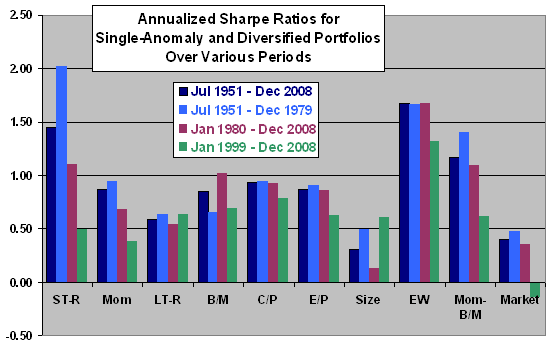Is diversification across equity anomalies beneficial? In his December 2009 preliminary paper entitled “Diversification Across Characteristics”, Erik Hjalmarsson combines long-short portfolios formed on seven stock anomalies:
- Short-term (one-month) reversal (ST-R)
- Medium-term (11 months plus skip-month) momentum (Mom)
- Long-term (four years plus skip-year) reversal (LT-R)
- Book-to-market value (B/M)
- Cash flow-to-price ratio (C/P)
- Earnings-to-price ratio (E/P)
- Market capitalization (Size)
The portfolio for each anomaly is long (short) on an equally weighted basis the tenth of stocks expected to generate the most positive (negative) returns, reformed each month. Using monthly firm characteristics and return data for all NYSE, AMEX and NASDAQ stocks over the period July 1951 through December 2008, he finds that:
- While each individual anomaly supports a profitable long-short hedge portfolio, returns for a diversified strategy that combines anomalies on an equally weighted basis dominates the performances of individual anomalies.
- Results are generally robust for subperiods (see chart below).
- The benefits of diversifying across anomalies derive mostly from low and sometimes substantially negative correlations between returns of pairs of individual anomalies. Specifically, correlations of portfolio returns:
- Between pairs of B/M, C/P and E/P are substantially positive.
- Between any of B/M, C/P and E/P and ST-R are mostly negative.
- Between any of B/M, C/P and E/P and Mom are weak.
- Between any of B/M, C/P and E/P and LT-R are generally positive.
- Between Size and Mom (LT-R) is negative (positive).
- Between ST-R and Mom (LT-R) is strongly negative (weakly positive).
- Results ignore trading frictions, which would lower returns, but perhaps not substantially for these types of portfolios.
The following chart, constructed from data in the paper, compares annualized Sharpe ratios over various periods for the seven single-anomaly long-short portfolios, a diversification strategy that equally weights all seven single-anomaly portfolios (EW), a diversification strategy that equally weights just the Mom and B/M anomalies (Mom-B/M) and the overall market. In almost all cases, EW outperforms the single-anomaly portfolios and Mom-B/M.

In summary, evidence from nearly six decades of data indicates that diversifying across stock return anomalies consistently beats individual anomalies and the broad stock market.
Skepticism about the insubstantiality of trading frictions may be in order. Only large investors have the potential to implement efficiently the large number of positions required for diversification across anomalies at the individual stock level. Moreover, the combined monthly requirements of reforming single-anomaly portfolios and rebalancing across anomalies potentially drive high turnover (with older parts of the sample carrying relatively high transaction costs and large bid-ask spreads).